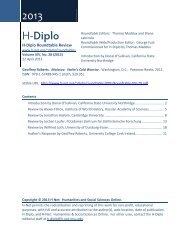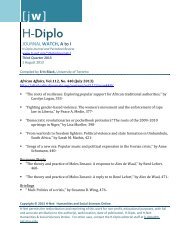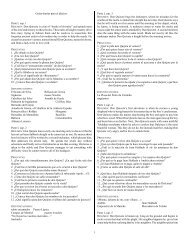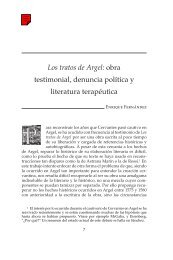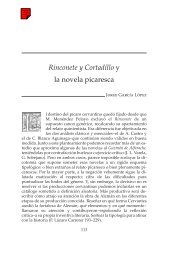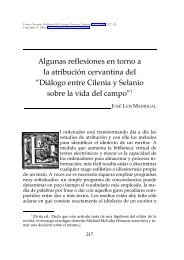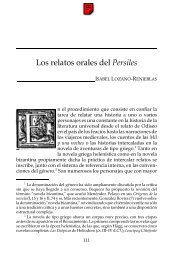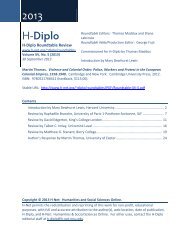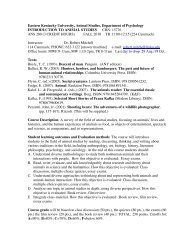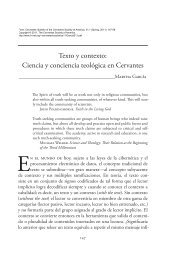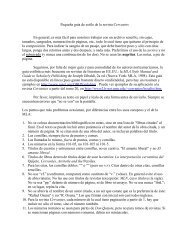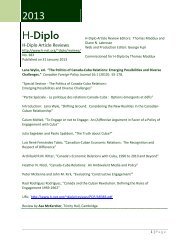The Function of Skepticism in Part I of Don Quijote - H-Net
The Function of Skepticism in Part I of Don Quijote - H-Net
The Function of Skepticism in Part I of Don Quijote - H-Net
Create successful ePaper yourself
Turn your PDF publications into a flip-book with our unique Google optimized e-Paper software.
Volume 30.2 (2010) <strong>The</strong> <strong>Function</strong> <strong>of</strong> <strong>Skepticism</strong><br />
133<br />
first appeared <strong>in</strong> 1620, it can be used to illustrate <strong>Don</strong> <strong>Quijote</strong>’s violation<br />
<strong>of</strong> skeptical doctr<strong>in</strong>e:<br />
And with regard to authority, it shows a feeble m<strong>in</strong>d to grant so<br />
much to authors and yet deny time his rights, who is the author <strong>of</strong><br />
authors, nay rather <strong>of</strong> all authority. For rightly is truth called the<br />
daughter <strong>of</strong> time, not <strong>of</strong> authority. It is no wonder therefore if those<br />
enchantments <strong>of</strong> antiquity and authority and consent have so bound<br />
up men’s powers that they have been made impotent (like persons<br />
bewitched) to accompany with the nature <strong>of</strong> th<strong>in</strong>gs. (1969, 120-1)<br />
Accord<strong>in</strong>g to the tradition we are tak<strong>in</strong>g <strong>in</strong>to account, the feebleness<br />
<strong>of</strong> <strong>Don</strong> <strong>Quijote</strong>’s m<strong>in</strong>d results from his dogmatism. He is “bewitched”<br />
because for him, the Romances <strong>of</strong> Chivalry have total authority. <strong>The</strong><br />
k<strong>in</strong>d <strong>of</strong> bewitchment he suffers is expla<strong>in</strong>ed accurately and concisely by<br />
Scott Paul Gordon, who takes advantage <strong>of</strong> the ideas <strong>of</strong> Francis Bacon:<br />
<strong>Don</strong> Quixote embodies an unpurged m<strong>in</strong>d. If Bacon likens a proper<br />
<strong>in</strong>tellect, one capable <strong>of</strong> discover<strong>in</strong>g the “nature <strong>of</strong> th<strong>in</strong>gs,” to a fair<br />
sheet <strong>of</strong> paper with no writ<strong>in</strong>g on it,” then Quixote’s m<strong>in</strong>d is disabled<br />
from f<strong>in</strong>d<strong>in</strong>g the “nature <strong>of</strong> th<strong>in</strong>gs” because it already has “writ<strong>in</strong>g on<br />
it.” <strong>Don</strong> Quixote’s m<strong>in</strong>d has been <strong>in</strong>scribed by the romances he has<br />
consumed, and his perceptual problems . . . confirm Bacon’s theory<br />
that the fictions <strong>in</strong>side our heads control not only our response to<br />
what we see but also what we see itself. (2006, 20) 20<br />
<strong>The</strong> best way to appreciate the extent <strong>of</strong> his bewitchment and also the<br />
harm that it causes him is by illustrat<strong>in</strong>g it with an example. <strong>Don</strong> <strong>Quijote</strong><br />
tries to improve his morriόn simple as follows:<br />
de cartones hizo a modo de media celada, que, encajada con el morrión,<br />
hacían apariencia de celada entera. Es verdad que para probar si<br />
era fuerte y podía estar al riesgo de una cuchillada, sacό su espada y le<br />
20 For further support, see Maureen Ihrie (1982, 30-53). She <strong>of</strong>fers an illum<strong>in</strong>at<strong>in</strong>g and<br />
detailed explanation <strong>of</strong> <strong>Don</strong> <strong>Quijote</strong>’s dogmatism <strong>in</strong> <strong>Part</strong> I.



